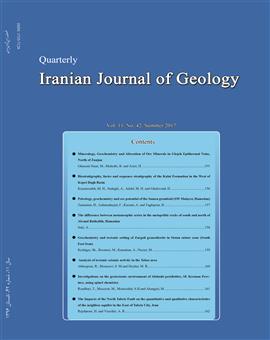بررسی تاثیر گسل شمال تبریز بر ویژگیهای کمی و کیفی منابع آب زیرزمینی مجاور در شرق تبریز
الموضوعات :ابراهیم رجب پور 1 , عبدالرضا واعظی هیر 2
1 -
2 - دانشکاه تبریز
الکلمات المفتاحية: هیدروژئولوژی زون گسلی آب¬, زیرزمینی گسل شمال تبریز ساختار آبخوان.,
ملخص المقالة :
بر اساس نتایج این مطالعه، گسل شمال تبریز بهعنوان ساختار تکتونیکی برجسته در شمال غرب ایران تاثیر زیادی بر شرایط هیدروژئولوژیک آبخوان محلی منطقه داشته است. بر اساس بررسی های هیدرواستراتیگرافی لاگ چاه های منطقه، از تجمع توف های تراوا، آبخوان غیر محبوسی تشکیل شده و در کل منطقه بهصورت مستقیم بر روی مارن قرمز رنگ میوسن (سنگ کف)، قرار گرفته است. سنگ کف بخش شمالی آبخوان در ترازی بالاتر از سنگ کف بخش جنوبی قرار گرفته و می تواند دلیلی بر وجود حرکت شیبلغز معکوس گسل در این منطقه باشد که در اثر آن، بخش شمالی (فرادیواره) بر روی بخش جنوبی (فرودیواره) لغزیده است. اختلاف تراز سنگ کف در فاصله ای نسبتاً کم (کمتر از 200 متر)، می تواند نشانه ای بر شیب نزدیک به قائم برای گسل باشد. مجموع عمق چاه های بخش جنوبی، چهار برابر بخش شمالی و مجموع آبدهی سالانه چاه های بخش جنوبی در حدود هشت برابر بخش شمالی است. همچنین، اختلاف بین تراز سطح آب زیرزمینی طرفین گسل در برخی مقاطع در فاصله ای حدود 200 متر به بیش از هشت متر بالغ میشود. نتایج ارزیابی تغییرات کلر و EC، نشانه وجود تغییرات شدید کیفی آب زیرزمینی در عرض زون گسلی است. نتایج حاصله می تواند نشانه ای بر رفتار مانع وار گسل در مقابل جریان از عرض آن در این منطقه باشد. بررسي سختی کل و غلظت يون هاي موجود در آب هاي منطقه نشان میدهد كه اكثر نمونه-هاي بخش شمالی جهت مصارف شرب مناسب نمی باشند ولی نمونه های بخش جنوبی جهت شرب مناسب می باشند. درحالیکه تمامی نمونه های بخش شمالی دارای ضریب لانژلیه منفی (خورنده) می باشد. تمامی نمونه های بخش جنوبی دارای ضریب لانژلیه مثبت خیلی نزدیک به صفر بوده و حاکی از متعادل بودن این آب ها می باشد. این امر با واقعیت منطقه نیز تطابق کامل دارد چرا که اکثر صنایع موجود در منطقه در بخش جنوبی گسل متمرکز شده اند.
- Anderson, E. and Bakker, M., 2008. Groundwater flow through anisotropic fault zones in multi-aquifer systems. Water Resource Research, 44, W11433.
- Bense, VF., Gleeson, T., Loveless, SE., Bour, O. and Scibek, J., 2013. Fault zone hydrogeology. Earth Science Reviews, 127, 171–192.
- Bethke, CM. and Johnson, TM., 2008. Groundwater age and groundwater age dating. Annu. Rev. Earth Planet Science, Vol, 36, 121–152.
- Burbey, T., 2008. The influence of geologic structures on deformation due to ground water withdrawal. Ground Water, 46, 202–211.
- Caine, JS., Evans, JP. and Forster, CB., 1996. Fault zone architecture and permeability structure. Geology, 24, 1025–1028.
- Chester, FM. and Logan, JM., 1986. Implications for mechanical properties of brittle faults from observations of the Punchbowl fault zone, California. Pure Applied Geophysics, 124, 80–106.
- Djamour, Y., Vernant, P., Nankali, HR. and Tavakoli, F., 2011. NW Iran-eastern Turkey present-day kinematics: Results from the Iranian permanent GPS network. Earth and Planetary Science Letters, 307, 27–34.
Emberger, L., 1955. Une classification biogeography que des climats. Recueil des Travaux Laboratoire Botanique Facult´e des Sciences, 7, 3–43.
- Folch, A. and Mas-Pla, J., 2008. Hydrogeological interactions between fault zones and alluvial aquifers in regional flow systems. Hydrological Process, 22, 3476–3487.
- Forster, CB. and Evans, JP., 1991. Hydrogeology of thrust faults and crystalline thrust sheets: results of combined field and modeling studies. Geophysics Research Letters, 18, 979–982.
- Geraud, Y., Diraison, M. and Orellana, N., 2006. Fault zone geometry of a mature active normal fault: a potential high permeability channel (Pirgaki fault, Corinth rift, Greece). Tectonophysics, 246, 61–76.
- Goldscheider, N., 2008. Methods in karst hydrogeology, International Contributions to Hydrogeology, 279 p.
- Haneberg, WC., 1995. Steady state groundwater flow across idealized faults. Water Resource. Research, 31 (7), 1815–1820.
- Jackson, J., 1992. Partitioning of strike-slip and convergent motion between Eurasia and Arabia in Eastern Turkey and the Caucasus. Journal of Geophysics Research, 97, 471–12479.
- Leray, S., de Dreuzy, JR., Bour, O., Labasque, T. and Aquilina, L., 2012. Contribution of age data to the characterization of complex aquifers. Journal of Hydrology, Vol. 464–465, 54–68.
- Mayer, A., May, W., Lukkarila, C. and Diehl, J., 2007. Estimation of fault-zone conductance by calibration of a regional groundwater flow model: Desert Hot Springs, California. Hydrogeology Journal, 15, 1093–1106.
- Milanovic, PT., 1988. karst Hydrogeology. Water Resources publication.
- Moradi, AS., Hatzfeld, D. and Tatar, M., 2011. Microseismicity and seismotectonics of the North Tabriz fault (Iran). Tectonophysics, 506, 22–30.
- Rawling, G. and Goodwin, L., 2003. Cataclasis and particulate flow in faulted, poorly lithified sediments. Journal of Struct ural Geology, 25, 317–331.
- Sengor, AMC., Tuysuz, O., Imren, C., Saking, M., Eyidogan, H., Gorur, N., Le Pichon, X. and Rangin, C., 2005. The North Anatolian Fault: A new look. Earth Science Reviews, 33.
- Vafaei, J., Taghikhany, T. and Tehranizadeh, M., 2011. Near field effect on horizontal equal-hazard spectrum of Tabriz city in north-west of Iran. International Journal of Civil Engineering, 9, 49-56.
- White, WB., 1988. Geomorphology and Hydrology of Karst Terrains. Oxford University Press: New York.464.


